Community Disassembly in Ephemeral Ecosystems
26 Pages7503 Words40 Views
Added on 2023-01-19
About This Document
This article discusses the process of community disassembly in ephemeral ecosystems, focusing on the mechanisms and patterns of disassembly. It explores how decreasing habitat size, harshening habitat conditions, ultraviolet light exposure, and the collapse of the entire metacommunity contribute to the disassembly process. The article also highlights the importance of understanding natural disassembly in shaping ecosystem structure and function.
Community Disassembly in Ephemeral Ecosystems
Added on 2023-01-19
ShareRelated Documents
Accepted ArticleAccepted Article
This article has been accepted for publication and undergone full peer review but has not been
through the copyediting, typesetting, pagination and proofreading process, which may lead to
differences between this version and the Version of Record. Please cite this article as doi:
10.1002/ecy.1604
This article is protected by copyright. All rights reserved.
Received Date : 08-Mar-2016
Revised Date : 16-Sep-2016
Accepted Date : 26-Sep-2016
Article type : Concepts & Synthesis
Community Disassembly in Ephemeral Ecosystems
Running Head: Disassembly of Ephemeral Ecosystems
Brian J. O’Neill
Department of Biological Sciences
800 W Main St., University of Wisconsin – Whitewater, Whitewater WI 53190
Telephone: 262-472-1455; Fax: 262-472-5633
Email: oneillb@uww.edu
Abstract
Community disassembly is the non-random process of progressive species declines and
losses. This process is usually studied to determine how various forces extirpate species, such as
catastrophic disturbance, species invasions, habitat fragmentation, or unnatural/anthropogenic
stressors. However, in ephemeral ecosystems, community disassembly is a natural and
repeatable process. While many ephemeral ecosystems are aquatic (vernal pools, playa lakes,
rock pools, saline lakes, phytotelmata, etc.), some disassembly patterns are applicable to other
ecosystem types, including terrestrial ecosystems.
This article has been accepted for publication and undergone full peer review but has not been
through the copyediting, typesetting, pagination and proofreading process, which may lead to
differences between this version and the Version of Record. Please cite this article as doi:
10.1002/ecy.1604
This article is protected by copyright. All rights reserved.
Received Date : 08-Mar-2016
Revised Date : 16-Sep-2016
Accepted Date : 26-Sep-2016
Article type : Concepts & Synthesis
Community Disassembly in Ephemeral Ecosystems
Running Head: Disassembly of Ephemeral Ecosystems
Brian J. O’Neill
Department of Biological Sciences
800 W Main St., University of Wisconsin – Whitewater, Whitewater WI 53190
Telephone: 262-472-1455; Fax: 262-472-5633
Email: oneillb@uww.edu
Abstract
Community disassembly is the non-random process of progressive species declines and
losses. This process is usually studied to determine how various forces extirpate species, such as
catastrophic disturbance, species invasions, habitat fragmentation, or unnatural/anthropogenic
stressors. However, in ephemeral ecosystems, community disassembly is a natural and
repeatable process. While many ephemeral ecosystems are aquatic (vernal pools, playa lakes,
rock pools, saline lakes, phytotelmata, etc.), some disassembly patterns are applicable to other
ecosystem types, including terrestrial ecosystems.
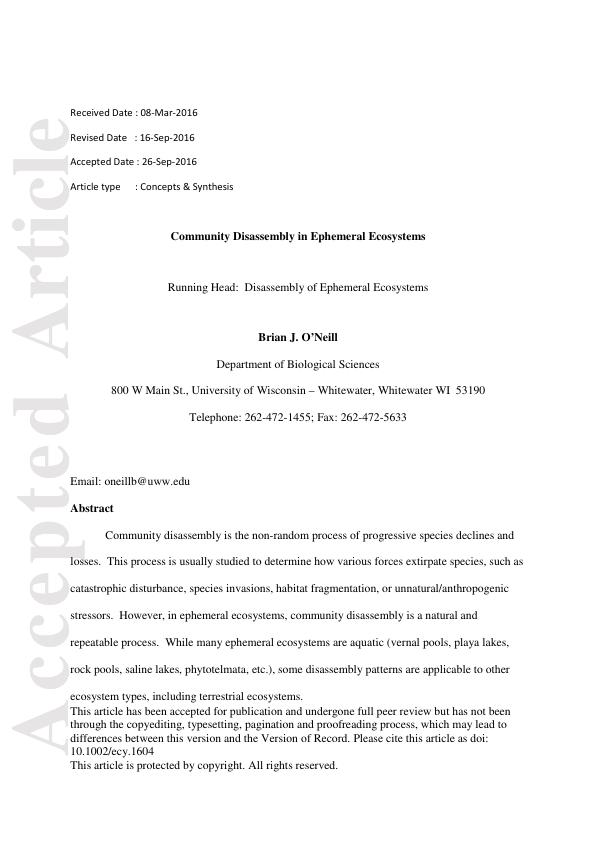
Accepted ArticleAccepted Article
This article is protected by copyright. All rights reserved.
As ephemeral waterbodies near the end of their hydroperiod, certain aspects
fundamentally change. These fundamental changes or mechanisms cause visible patterns of
community disassembly. Decreasing habitat size eliminates microhabitats and increases
encounter rates between organisms, possibly increasing predation and competition. A
harshening habitat eliminates low-tolerance species, changes the proportions of
specialists/generalists, and forces organisms to acclimate, emigrate, or die. Additionally,
ultraviolet light affects more of the water column, eliminating unprotected species. Furthermore,
the entire metacommunity is often in similar stages of disassembly and collapses. Many of these
mechanisms drive disassembly of terrestrial ephemeral habitats, such as animal carcasses, dung
pads, or fungal fruiting bodies.
Organisms obligate to ephemeral habitats have evolved to optimize their life history for a
rapid lifecycle with specific adaptations for themselves or their offspring to survive through the
inactive period of the ecosystem. While some disassembly may occur too fast for biotic
interactions or compensatory dynamics to be important, organisms undergoing natural
disassembly should “expect” it. Thus, predictions of disassembly based on internal or biotic
patterns may be more common in natural disassembly scenarios than in human-induced
disassembly of permanent ecosystems. Additionally, natural community disassembly should be
more predictable and understandable than a permanent community’s reaction to a never-before-
seen anthropogenic disturbance.
Community disassembly is an important ecological component of ephemeral ecosystems.
The processes that occur during disassembly shape assemblages over ecologically and
evolutionary relevant timescales. Understanding how natural disassembly can feed back to
This article is protected by copyright. All rights reserved.
As ephemeral waterbodies near the end of their hydroperiod, certain aspects
fundamentally change. These fundamental changes or mechanisms cause visible patterns of
community disassembly. Decreasing habitat size eliminates microhabitats and increases
encounter rates between organisms, possibly increasing predation and competition. A
harshening habitat eliminates low-tolerance species, changes the proportions of
specialists/generalists, and forces organisms to acclimate, emigrate, or die. Additionally,
ultraviolet light affects more of the water column, eliminating unprotected species. Furthermore,
the entire metacommunity is often in similar stages of disassembly and collapses. Many of these
mechanisms drive disassembly of terrestrial ephemeral habitats, such as animal carcasses, dung
pads, or fungal fruiting bodies.
Organisms obligate to ephemeral habitats have evolved to optimize their life history for a
rapid lifecycle with specific adaptations for themselves or their offspring to survive through the
inactive period of the ecosystem. While some disassembly may occur too fast for biotic
interactions or compensatory dynamics to be important, organisms undergoing natural
disassembly should “expect” it. Thus, predictions of disassembly based on internal or biotic
patterns may be more common in natural disassembly scenarios than in human-induced
disassembly of permanent ecosystems. Additionally, natural community disassembly should be
more predictable and understandable than a permanent community’s reaction to a never-before-
seen anthropogenic disturbance.
Community disassembly is an important ecological component of ephemeral ecosystems.
The processes that occur during disassembly shape assemblages over ecologically and
evolutionary relevant timescales. Understanding how natural disassembly can feed back to
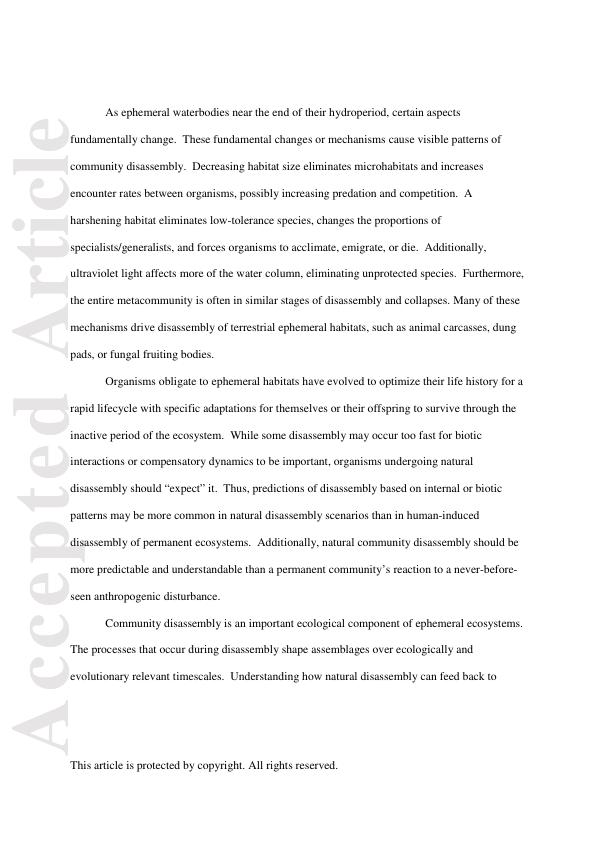
Accepted ArticleAccepted Article
This article is protected by copyright. All rights reserved.
ultimately drive ecosystem structure and function increases our knowledge of fundamental
ecology and provides for a new frontier of study.
Keywords: biodiversity, community assembly rules, ephemeral wetland, food web assembly,
succession, temporary wetlands, vernal pools
Introduction
Community disassembly is the non-random process of progressive species declines and
losses (Zavaleta et al. 2009), and is usually studied in the context of how communities or food
webs lose species to a variety of forces, such as species invasions (e.g. Sanders et al. 2003,
Rodriguez-Cabal 2013), catastrophic disturbance (e.g. Tate and Battaglia 2013, Emslie et al.
2014), habitat fragmentation (e.g. Lomolino and Perault 2000, Larsen et al. 2008), or
unnatural/anthropogenic stressors (e.g. Sheldon et al. 2011, Lindo et al. 2012, Tognetti and
Chaneton 2015). Community disassembly is a complex process that can have somewhat
unpredictable outcomes because it varies as a function of ecosystem type, taxonomic group, and
environmental and geographic context (Zavaleta et al. 2009). Yet, in response to
negative/anthropogenic forces, community disassembly can occur in non-random manners
(Zavaleta et al. 2009), based on traits, such as trophic position, body size, and dispersal ability
(Didham et al. 1998, Gonzalez and Chaneton 2002, Cardillo 2003), among others. All of these
scenarios are a result of negative impacts to the ecosystem.
However, in ephemeral/temporary ecosystems, community disassembly is a natural
process that happens repeatedly. Many organisms have long evolutionary histories with, and are
adapted to, disassembly. Organisms in ephemeral ecosystems develop faster and emerge earlier
(e.g. Delucchi and Peckarsky 1989) and tend to show more multivoltinism (e.g. Way et al. 1980,
This article is protected by copyright. All rights reserved.
ultimately drive ecosystem structure and function increases our knowledge of fundamental
ecology and provides for a new frontier of study.
Keywords: biodiversity, community assembly rules, ephemeral wetland, food web assembly,
succession, temporary wetlands, vernal pools
Introduction
Community disassembly is the non-random process of progressive species declines and
losses (Zavaleta et al. 2009), and is usually studied in the context of how communities or food
webs lose species to a variety of forces, such as species invasions (e.g. Sanders et al. 2003,
Rodriguez-Cabal 2013), catastrophic disturbance (e.g. Tate and Battaglia 2013, Emslie et al.
2014), habitat fragmentation (e.g. Lomolino and Perault 2000, Larsen et al. 2008), or
unnatural/anthropogenic stressors (e.g. Sheldon et al. 2011, Lindo et al. 2012, Tognetti and
Chaneton 2015). Community disassembly is a complex process that can have somewhat
unpredictable outcomes because it varies as a function of ecosystem type, taxonomic group, and
environmental and geographic context (Zavaleta et al. 2009). Yet, in response to
negative/anthropogenic forces, community disassembly can occur in non-random manners
(Zavaleta et al. 2009), based on traits, such as trophic position, body size, and dispersal ability
(Didham et al. 1998, Gonzalez and Chaneton 2002, Cardillo 2003), among others. All of these
scenarios are a result of negative impacts to the ecosystem.
However, in ephemeral/temporary ecosystems, community disassembly is a natural
process that happens repeatedly. Many organisms have long evolutionary histories with, and are
adapted to, disassembly. Organisms in ephemeral ecosystems develop faster and emerge earlier
(e.g. Delucchi and Peckarsky 1989) and tend to show more multivoltinism (e.g. Way et al. 1980,
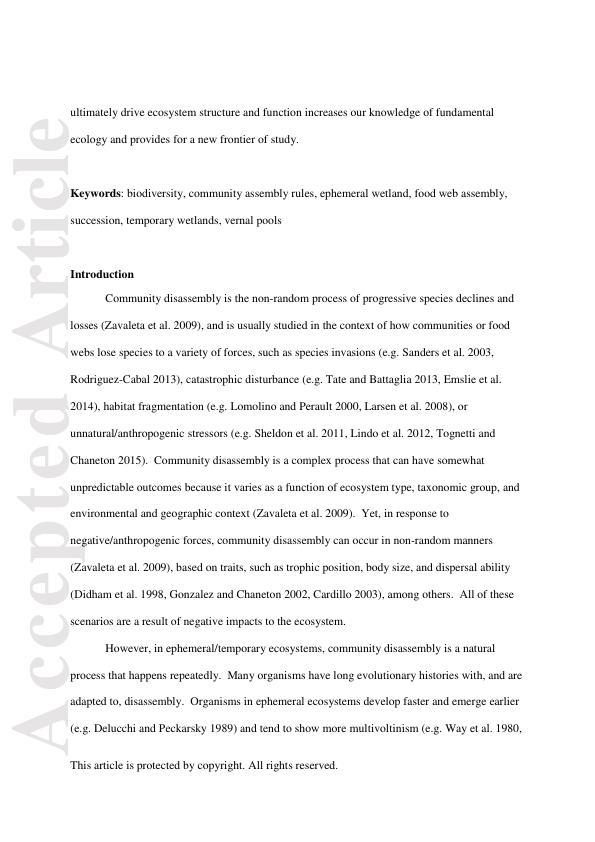
Accepted ArticleAccepted Article
This article is protected by copyright. All rights reserved.
Dana 1981). Some even require ecosystem collapse for completion of their lifecycle [e.g. many
branchiopod crustaceans (Brendonck 1996)].
Ephemeral wetlands or ponds are some of the most common temporary ecosystems, are
found throughout the world in a variety of configurations and landscapes, and are partly defined
by their recurring dry period (Williams 2006). While characteristics across different ephemeral
waterbodies are highly variable, the community usually assembles after filling, and as the
wetland gradually dries, the community disassembles. This disassembly (Fig. 1) is done via taxa
emigration, inactivation (e.g. diapause, resting eggs, torpor, etc.), or elimination (simply killed).
While much succession research concentrates on how the sequence of community assembly
shapes the current and future assemblage, I submit that the sequence of disassembly has an
equally strong effect on future instances of ephemeral community activity. Herein, I discuss
patterns of community disassembly in a generalized ephemeral wetland. I do not mean to target
a specific classification of waterbody, but some of the patterns are assuredly more applicable to
specific habitats/ecosystem types. This framework is applicable to other types of ephemeral
habitats, such as dung pads, animal carcasses, and ephemeral streams, among others. To my
knowledge, this is the first attempt to synthesize ideas of natural community disassembly.
Organisms common to ephemeral waterbodies are known for their adaptations to
withstand harshening conditions, such as water loss (Williams 2006). The success of species in
an ephemeral waterbody relies on special adaptations of an organism’s physiology and behavior.
Many species have evolved from terrestrial groups and the problems of adapting to water loss
may not be that difficult (Williams 2006). There is a wide variety of these adaptations due to the
unique selection pressures in each unique habitat. However, these adaptations are often grouped
in three areas: behavioral avoidance, timing of growth and emergence, and dormancy and
This article is protected by copyright. All rights reserved.
Dana 1981). Some even require ecosystem collapse for completion of their lifecycle [e.g. many
branchiopod crustaceans (Brendonck 1996)].
Ephemeral wetlands or ponds are some of the most common temporary ecosystems, are
found throughout the world in a variety of configurations and landscapes, and are partly defined
by their recurring dry period (Williams 2006). While characteristics across different ephemeral
waterbodies are highly variable, the community usually assembles after filling, and as the
wetland gradually dries, the community disassembles. This disassembly (Fig. 1) is done via taxa
emigration, inactivation (e.g. diapause, resting eggs, torpor, etc.), or elimination (simply killed).
While much succession research concentrates on how the sequence of community assembly
shapes the current and future assemblage, I submit that the sequence of disassembly has an
equally strong effect on future instances of ephemeral community activity. Herein, I discuss
patterns of community disassembly in a generalized ephemeral wetland. I do not mean to target
a specific classification of waterbody, but some of the patterns are assuredly more applicable to
specific habitats/ecosystem types. This framework is applicable to other types of ephemeral
habitats, such as dung pads, animal carcasses, and ephemeral streams, among others. To my
knowledge, this is the first attempt to synthesize ideas of natural community disassembly.
Organisms common to ephemeral waterbodies are known for their adaptations to
withstand harshening conditions, such as water loss (Williams 2006). The success of species in
an ephemeral waterbody relies on special adaptations of an organism’s physiology and behavior.
Many species have evolved from terrestrial groups and the problems of adapting to water loss
may not be that difficult (Williams 2006). There is a wide variety of these adaptations due to the
unique selection pressures in each unique habitat. However, these adaptations are often grouped
in three areas: behavioral avoidance, timing of growth and emergence, and dormancy and
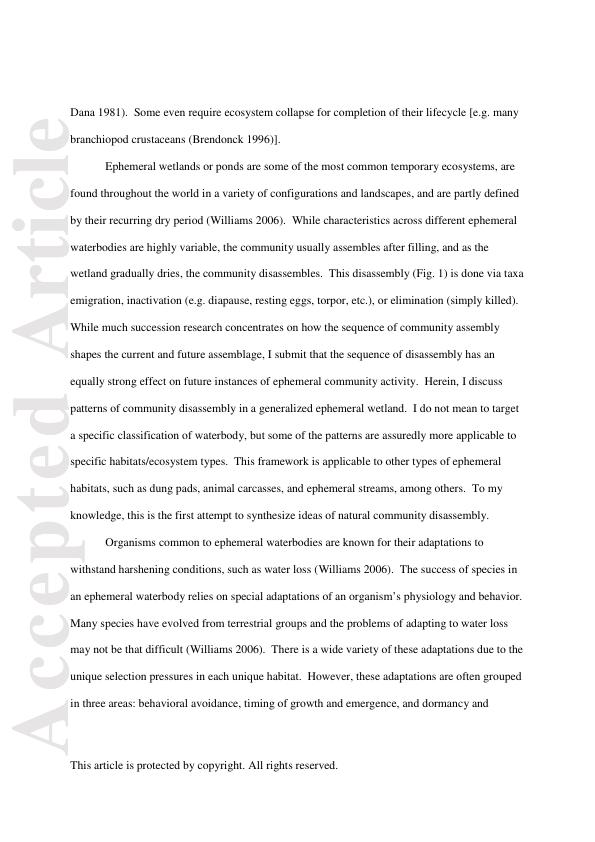
Accepted ArticleAccepted Article
This article is protected by copyright. All rights reserved.
hatching response (Williams 2006). Some combination of these adaptations impart the ability
for continued survival in these harsh habitats. Yet, the complete disappearance of an aquatic
environment precludes the persistence of organisms (aquatic phase) with even the widest
tolerance ranges [e.g. tadpole shrimp (Crustacea: Notostraca) persist as resting eggs]. Thus, the
assemblage of an ephemeral waterbody changes as it dries, depending on the organisms’ traits.
Whole species and taxonomic groups emigrate to continue life in other waterbodies. Other taxa
reproduce and naturally senesce before the water is completely gone, while still others are simply
eliminated from the habitat as they are trying to complete their lifecycle. The traits of the taxa
interacting with the biotic and abiotic context of the environment then create a partly predictable
sequence or pattern of disassembly.
Mechanisms and patterns of disassembly
Belyea and Lancaster (1999), in their comprehensive review of assembly rules, advocated
for an identification of the underlying mechanism that caused the observed assembly pattern, not
simply showing patterns of assembly for specific taxa in a particular context. Following that
convention, Table 1 contains mechanisms common to most ephemeral waterbodies, followed by
expected patterns created by those mechanisms. Essentially, this is akin to showing cause
(mechanism) and effect (patterns). In addition, Table 1 contains testable predictions proceeding
from each pattern. The mechanisms, patterns, and predictions of community disassembly
discussed herein are meant as a heuristic framework. Addition and revision to this framework
will only improve its quality and usefulness.
As an ephemeral waterbody nears the end of its hydroperiod, certain aspects of the
waterbody fundamentally change. These fundamental changes are the mechanisms that produce
This article is protected by copyright. All rights reserved.
hatching response (Williams 2006). Some combination of these adaptations impart the ability
for continued survival in these harsh habitats. Yet, the complete disappearance of an aquatic
environment precludes the persistence of organisms (aquatic phase) with even the widest
tolerance ranges [e.g. tadpole shrimp (Crustacea: Notostraca) persist as resting eggs]. Thus, the
assemblage of an ephemeral waterbody changes as it dries, depending on the organisms’ traits.
Whole species and taxonomic groups emigrate to continue life in other waterbodies. Other taxa
reproduce and naturally senesce before the water is completely gone, while still others are simply
eliminated from the habitat as they are trying to complete their lifecycle. The traits of the taxa
interacting with the biotic and abiotic context of the environment then create a partly predictable
sequence or pattern of disassembly.
Mechanisms and patterns of disassembly
Belyea and Lancaster (1999), in their comprehensive review of assembly rules, advocated
for an identification of the underlying mechanism that caused the observed assembly pattern, not
simply showing patterns of assembly for specific taxa in a particular context. Following that
convention, Table 1 contains mechanisms common to most ephemeral waterbodies, followed by
expected patterns created by those mechanisms. Essentially, this is akin to showing cause
(mechanism) and effect (patterns). In addition, Table 1 contains testable predictions proceeding
from each pattern. The mechanisms, patterns, and predictions of community disassembly
discussed herein are meant as a heuristic framework. Addition and revision to this framework
will only improve its quality and usefulness.
As an ephemeral waterbody nears the end of its hydroperiod, certain aspects of the
waterbody fundamentally change. These fundamental changes are the mechanisms that produce
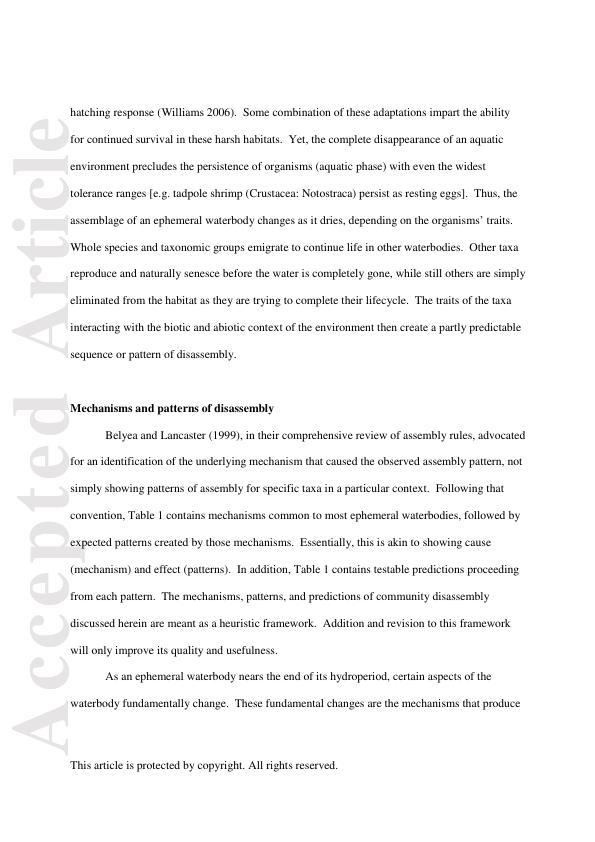
Accepted ArticleAccepted Article
This article is protected by copyright. All rights reserved.
the observable patterns of disassembly. First, water evaporates or percolates into the sediments
causing a decrease in water depth and a reduction of surface area. Both of these changes reduce
the size of the habitat (Table 1, part A). Second, the reduction in water volume often harshens
the habitat. Temperature/oxygen regimes, and salinity can drastically change, altering the
physicochemical environment of the waterbody (Table 1, part B). Third, ultraviolet light can
penetrate a higher proportion of the water column, potentially affecting more of the waterbody’s
inhabitants (Table 1, part C). Finally, the surrounding landscape of ephemeral waterbodies are
generally exposed to the same basic conditions, meaning the entire metacommunity may be in
similar stages of disassembly (Table 1, part D). This is by no means a comprehensive list of
fundamental changes that drive community disassembly, but they are common to many
ephemeral waterbodies.
Habitat size decreases
The most obvious change to an ephemeral wetland as it nears the end of its hydroperiod
is its decrease in size. This drastically affects many aspects of the waterbody, and many of the
fundamental changes listed above flow from, or are related to, decreases in habitat size. Habitat
size is well known to correlate with habitat heterogeneity and thus diversity (Munroe 1948,
MacArthur and Wilson 1963, Smith et al. 2005). O’Neill and Thorp (2014) found shallower
playas (ephemeral wetlands common to the U.S. Great Plains) to have more simple food webs
with shorter food chains. A shrinking wetland will lose some of its microhabitats, which reduces
diversity. This could strand less mobile organisms along the edges of the wetland or in small,
soon-to-disappear pockets of water that become disconnected from the main wetland, thereby
killing inhabitants and potentially eliminating entire species from the wetland.
This article is protected by copyright. All rights reserved.
the observable patterns of disassembly. First, water evaporates or percolates into the sediments
causing a decrease in water depth and a reduction of surface area. Both of these changes reduce
the size of the habitat (Table 1, part A). Second, the reduction in water volume often harshens
the habitat. Temperature/oxygen regimes, and salinity can drastically change, altering the
physicochemical environment of the waterbody (Table 1, part B). Third, ultraviolet light can
penetrate a higher proportion of the water column, potentially affecting more of the waterbody’s
inhabitants (Table 1, part C). Finally, the surrounding landscape of ephemeral waterbodies are
generally exposed to the same basic conditions, meaning the entire metacommunity may be in
similar stages of disassembly (Table 1, part D). This is by no means a comprehensive list of
fundamental changes that drive community disassembly, but they are common to many
ephemeral waterbodies.
Habitat size decreases
The most obvious change to an ephemeral wetland as it nears the end of its hydroperiod
is its decrease in size. This drastically affects many aspects of the waterbody, and many of the
fundamental changes listed above flow from, or are related to, decreases in habitat size. Habitat
size is well known to correlate with habitat heterogeneity and thus diversity (Munroe 1948,
MacArthur and Wilson 1963, Smith et al. 2005). O’Neill and Thorp (2014) found shallower
playas (ephemeral wetlands common to the U.S. Great Plains) to have more simple food webs
with shorter food chains. A shrinking wetland will lose some of its microhabitats, which reduces
diversity. This could strand less mobile organisms along the edges of the wetland or in small,
soon-to-disappear pockets of water that become disconnected from the main wetland, thereby
killing inhabitants and potentially eliminating entire species from the wetland.
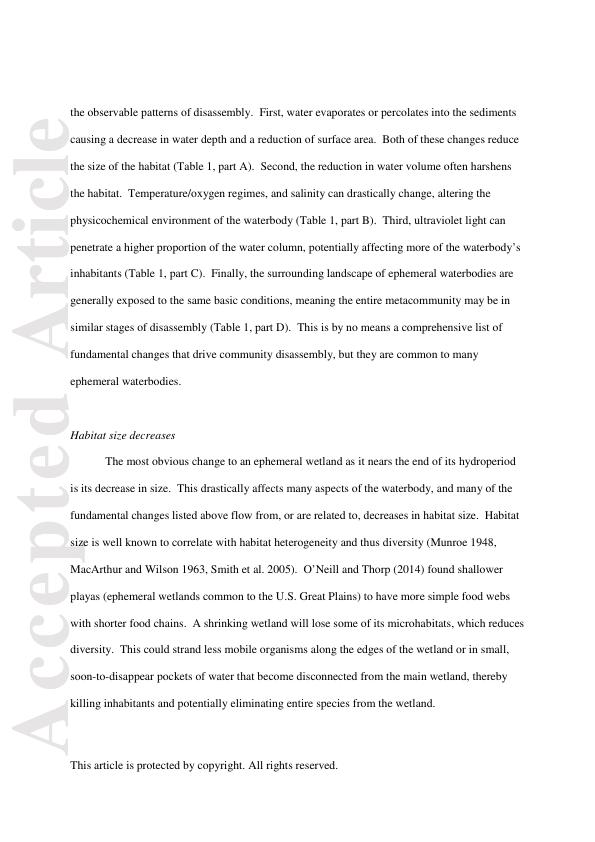
End of preview
Want to access all the pages? Upload your documents or become a member.
